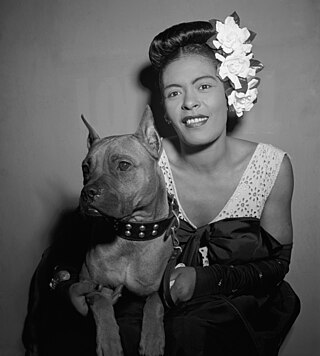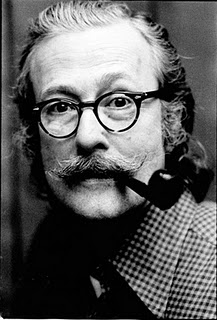Related Research Articles

Billie Holiday was an American jazz and swing music singer. Nicknamed "Lady Day" by her friend and music partner, Lester Young, Holiday made a significant contribution to jazz music and pop singing. Her vocal style, strongly influenced by jazz instrumentalists, inspired a new way of manipulating phrasing and tempo. She was known for her vocal delivery and improvisational skills.

Dinah Washington was an American singer and pianist, one of the most popular black female recording artists of the 1950s. Primarily a jazz vocalist, she performed and recorded in a wide variety of styles including blues, R&B, and traditional pop music, and gave herself the title of "Queen of the Blues". She was also known as "Queen of the Jukeboxes". She was a 1986 inductee of the Alabama Jazz Hall of Fame, and was inducted into the Rock and Roll Hall of Fame in 1993.

Joe Williams was an American jazz singer. He sang with big bands, such as the Count Basie Orchestra and the Lionel Hampton Orchestra, and with small combos. He sang in two films with the Basie orchestra and sometimes worked as an actor.

Kind of Blue is a studio album by the American jazz trumpeter and composer Miles Davis. It was released on August 17, 1959 through Columbia Records. For the recording, Davis led a sextet featuring saxophonists John Coltrane and Julian "Cannonball" Adderley, pianist Bill Evans, bassist Paul Chambers, and drummer Jimmy Cobb, with new band pianist Wynton Kelly appearing on one track—"Freddie Freeloader"—instead of Evans. The album was recorded in two sessions on March 2 and April 22, 1959, at Columbia's 30th Street Studio in New York City.

James Andrew Rushing was an American singer and pianist from Oklahoma City, Oklahoma, U.S., best known as the featured vocalist of Count Basie's Orchestra from 1935 to 1948.

Nathan Irving Hentoff was an American historian, novelist, jazz and country music critic, and syndicated columnist for United Media. Hentoff was a columnist for The Village Voice from 1958 to 2009. Following his departure from The Village Voice, Hentoff became a senior fellow at the Cato Institute and continued writing his music column for The Wall Street Journal, which published his works until his death. He often wrote on First Amendment issues, vigorously defending the freedom of the press.

Ralph Joseph Gleason was an American music critic and columnist. He contributed for many years to the San Francisco Chronicle, was a founding editor of Rolling Stone magazine, and cofounder of the Monterey Jazz Festival. A pioneering jazz and rock critic, he helped the San Francisco Chronicle transition into the rock era.

Vanguard Recording Society is an American record label set up in 1950 by brothers Maynard and Seymour Solomon in New York City. It was a primarily classical label at its peak in the 1950s and 1960s, but also has a catalogue of recordings by a number of pivotal jazz, folk, and blues musicians. The Bach Guild was a subsidiary label.
Jackie Washington was a Canadian blues musician.

South Carolina is one of the Southern United States and has produced a number of renowned performers of jazz, rock, blues, R&B, country, bluegrass and other popular styles.

Otis Rush Jr. was an American blues guitarist and singer-songwriter. His distinctive guitar style featured a slow-burning sound and long bent notes. With qualities similar to the styles of other 1950s artists Magic Sam and Buddy Guy, his sound became known as West Side Chicago blues and was an influence on many musicians, including Michael Bloomfield, Peter Green and Eric Clapton.
The Memphis Jug Band was an American musical group active from the mid-1920s to the late-1950s. The band featured harmonica, kazoo, fiddle and mandolin or banjolin, backed by guitar, piano, washboard, washtub bass and jug. They played slow blues, pop songs, humorous songs and upbeat dance numbers with jazz and string band flavors. The band made the first commercial recordings in Memphis, Tennessee, and recorded more sides than any other prewar jug band.

Cadence: The Independent Journal of Creative Improvised Music is a quarterly review of jazz, blues and improvised music. The magazine covers a range of styles, from early jazz and blues to the avant-garde. Critic and historian Bob Rusch founded the magazine as a monthly in 1976 and served as publisher and coordinating editor through 2011. Musician David Haney became editor and publisher in 2012.

Guitarist is a British monthly music-making magazine published by Future plc. It is the longest-established European guitar-player magazine, and is currently the biggest-selling guitar magazine in the UK. The magazine's current editor is Jamie Dickson, who has been in charge since late 2013. Each issue covers three areas: reviews, interview and technique. This may include reviews of newly released guitars, amplifiers and other equipment; interviews with famous and up-and-coming guitar players; and features on the guitar industry, news articles, playing technique with tablature. Guitarist's slogan was previously "The Guitar Player's Bible", before changing in 2012 to "The Guitar Magazine". In 2024 it will celebrate its 40th anniversary.
Martin Tudor Hansford Williams was an American jazz critic and writer.

Although it is billed as a Duke Ellington and Johnny Hodges album, Side by Side is a 1959 album mostly under the leadership of Johnny Hodges, Duke Ellington's alto saxophonist for many years. Ellington only appears on three of this album's tracks. The album places Hodges at the fore, backing him with piano by Ellington or Billy Strayhorn and providing other accompaniment by jazz figures like Ben Webster, Roy Eldridge, Harry "Sweets" Edison and Jo Jones. The album, a follow-up to Back to Back: Duke Ellington and Johnny Hodges Play the Blues, has remained perpetually in print.
Valerie Sybil Wilmer is a British photographer and writer specialising in jazz, gospel, blues, and British African-Caribbean music and culture. Her notable books include Jazz People (1970) and As Serious As Your Life (1977), both first published by Allison and Busby. Wilmer's autobiography, Mama Said There'd Be Days Like This: My Life in the Jazz World, was published in 1989.
Women in jazz have contributed throughout the many eras of jazz history, both as performers and as composers, songwriters and bandleaders. While women such as Billie Holiday and Ella Fitzgerald were famous for their jazz singing, women have achieved much less recognition for their contributions as composers, bandleaders and instrumental performers. Other notable jazz women include piano player Lil Hardin Armstrong and jazz songwriters Irene Higginbotham and Dorothy Fields.

Portrait of Sheila is the 1963 debut album of American jazz singer Sheila Jordan, released by Blue Note Records. In the 1963 DownBeat magazine Critics Poll, she was ranked first in the vocal category for "Talent Deserving Wider Recognition". She did not record again as a leader for more than a dozen years.
The Jazz Discography is a print, CD-ROM, and online discography and sessionography of all categories of recorded jazz — and directly relevant precursors of recorded jazz from 1896. The publisher, Lord Music Reference Inc., a British Columbia company, is headed by Tom Lord and is based in Chilliwack, British Columbia, Canada. The initial 26 of 35 print volumes, which comprise the discography, were issued from 1992 to 2001 in alphabetic order. In 2002, The Jazz Discography became the first comprehensive jazz discography on CD-ROM.
References
- ↑ "The Jazz Review : Jazz Studies Online" . Retrieved January 29, 2016.
- ↑ The Jazz Review, Vol. 2, No. 5, June 1959, page 37, accessed printed copy 2016-01-29.
- ↑ Hsio Wen Shih, who contributed an article on blues singers to the initial issue of The Jazz Review, was "an architect and expert in acoustics, ... a student of the music of many cultures", according to that issue. "The Jazz Review, Vol. 1, No. 1, Nov. 1958, page 50" . Retrieved January 29, 2016.